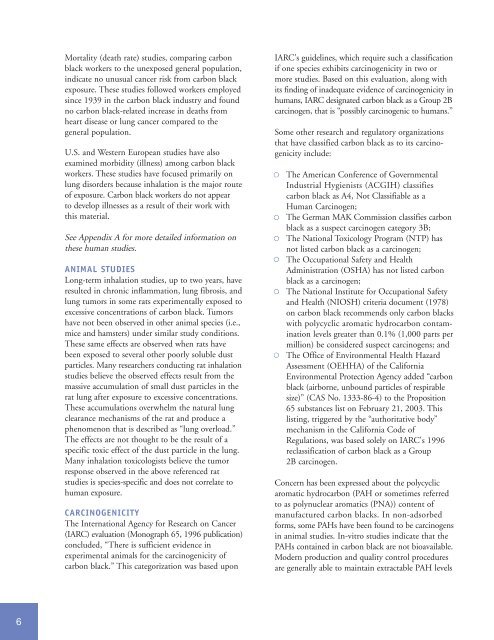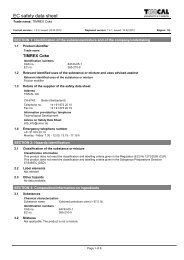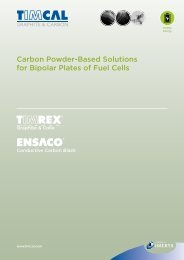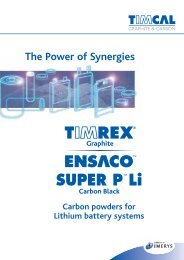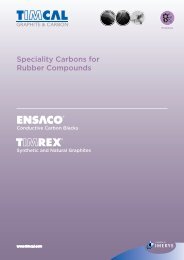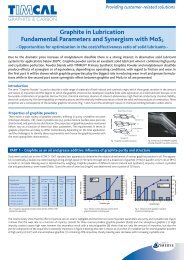Carbon Black Users Guide - Timcal
Carbon Black Users Guide - Timcal
Carbon Black Users Guide - Timcal
You also want an ePaper? Increase the reach of your titles
YUMPU automatically turns print PDFs into web optimized ePapers that Google loves.
Mortality (death rate) studies, comparing carbonblack workers to the unexposed general population,indicate no unusual cancer risk from carbon blackexposure. These studies followed workers employedsince 1939 in the carbon black industry and foundno carbon black-related increase in deaths fromheart disease or lung cancer compared to thegeneral population.U.S. and Western European studies have alsoexamined morbidity (illness) among carbon blackworkers. These studies have focused primarily onlung disorders because inhalation is the major routeof exposure. <strong>Carbon</strong> black workers do not appearto develop illnesses as a result of their work withthis material.See Appendix A for more detailed information onthese human studies.ANIMAL STUDIESLong-term inhalation studies, up to two years, haveresulted in chronic inflammation, lung fibrosis, andlung tumors in some rats experimentally exposed toexcessive concentrations of carbon black. Tumorshave not been observed in other animal species (i.e.,mice and hamsters) under similar study conditions.These same effects are observed when rats havebeen exposed to several other poorly soluble dustparticles. Many researchers conducting rat inhalationstudies believe the observed effects result from themassive accumulation of small dust particles in therat lung after exposure to excessive concentrations.These accumulations overwhelm the natural lungclearance mechanisms of the rat and produce aphenomenon that is described as “lung overload.”The effects are not thought to be the result of aspecific toxic effect of the dust particle in the lung.Many inhalation toxicologists believe the tumorresponse observed in the above referenced ratstudies is species-specific and does not correlate tohuman exposure.CARCINOGENICITYThe International Agency for Research on Cancer(IARC) evaluation (Monograph 65, 1996 publication)concluded, “There is sufficient evidence inexperimental animals for the carcinogenicity ofcarbon black.” This categorization was based uponIARC's guidelines, which require such a classificationif one species exhibits carcinogenicity in two ormore studies. Based on this evaluation, along withits finding of inadequate evidence of carcinogenicity inhumans, IARC designated carbon black as a Group 2Bcarcinogen, that is “possibly carcinogenic to humans.”Some other research and regulatory organizationsthat have classified carbon black as to its carcinogenicityinclude:The American Conference of GovernmentalIndustrial Hygienists (ACGIH) classifiescarbon black as A4, Not Classifiable as aHuman Carcinogen;The German MAK Commission classifies carbonblack as a suspect carcinogen category 3B;The National Toxicology Program (NTP) hasnot listed carbon black as a carcinogen;The Occupational Safety and HealthAdministration (OSHA) has not listed carbonblack as a carcinogen;The National Institute for Occupational Safetyand Health (NIOSH) criteria document (1978)on carbon black recommends only carbon blackswith polycyclic aromatic hydrocarbon contaminationlevels greater than 0.1% (1,000 parts permillion) be considered suspect carcinogens; andThe Office of Environmental Health HazardAssessment (OEHHA) of the CaliforniaEnvironmental Protection Agency added “carbonblack (airborne, unbound particles of respirablesize)” (CAS No. 1333-86-4) to the Proposition65 substances list on February 21, 2003. Thislisting, triggered by the “authoritative body”mechanism in the California Code ofRegulations, was based solely on IARC's 1996reclassification of carbon black as a Group2B carcinogen.Concern has been expressed about the polycyclicaromatic hydrocarbon (PAH or sometimes referredto as polynuclear aromatics (PNA)) content ofmanufactured carbon blacks. In non-adsorbedforms, some PAHs have been found to be carcinogensin animal studies. In-vitro studies indicate that thePAHs contained in carbon black are not bioavailable.Modern production and quality control proceduresare generally able to maintain extractable PAH levels6


